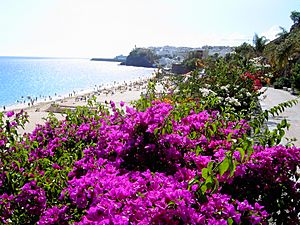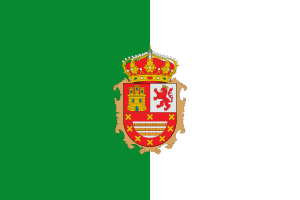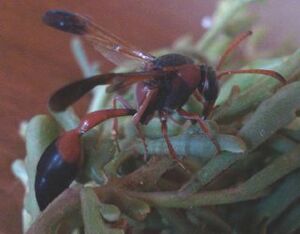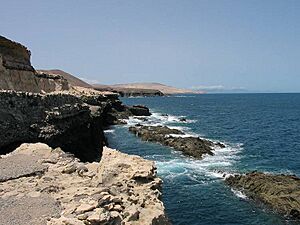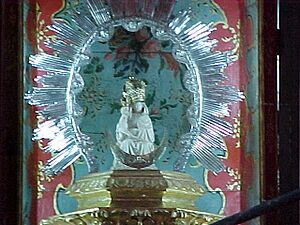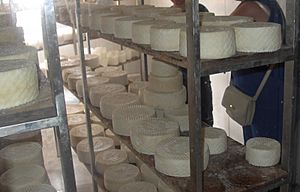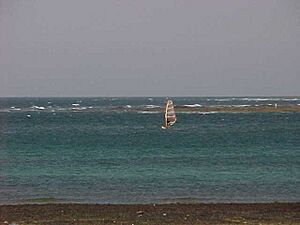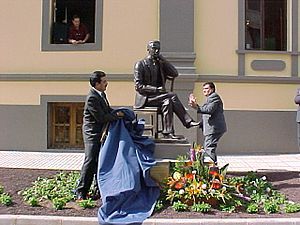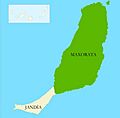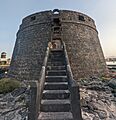Fuerteventura facts for kids
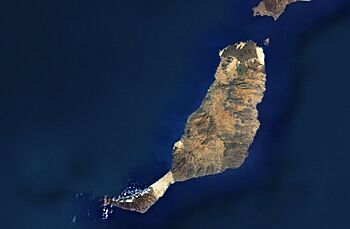
Satellite view (2011)
|
|
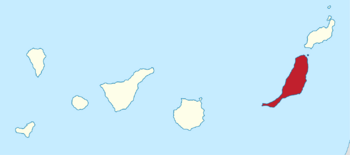 |
|
| Geography | |
|---|---|
| Location | Atlantic Ocean |
| Coordinates | 28°24′N 14°00′W / 28.400°N 14.000°W |
| Archipelago | Canary Islands |
| Area | 1,659.74 km2 (640.83 sq mi) |
| Coastline | 304 km (188.9 mi) |
| Highest elevation | 807 m (2,648 ft) |
| Administration | |
|
Spain
|
|
| Autonomous Community | Canary Islands |
| Province | Las Palmas |
| Capital and largest city | Puerto del Rosario (pop. 43,493) |
| Demographics | |
| Demonym | majorero/-a |
| Population | 124,152 (start of 2023) |
| Pop. density | 74.8 /km2 (193.7 /sq mi) |
| Languages | Spanish, specifically Canarian Spanish |
| Ethnic groups | Spanish, Canary Islanders, other minority groups |
| Additional information | |
| Time zone |
|
| • Summer (DST) | |
Fuerteventura is a beautiful island in the Canary Islands, located in the Atlantic Ocean. It's part of Spain and is only about 97 kilometers (60 miles) from the coast of North Africa. In 2009, UNESCO declared the island a biosphere reserve, which means it's a special place protected for its nature.
Fuerteventura is part of the Province of Las Palmas. Its capital city is Puerto del Rosario, where the island's government, called the Island Council, is located. As of early 2023, Fuerteventura had 124,152 people living there. It's the fourth most populated Canary Island. With an area of 1,659.74 square kilometers (640.83 sq mi), it's the second largest Canary Island, after Tenerife. Geologists say Fuerteventura is the oldest island in the whole Canary Islands group.
Contents
- What's in a Name?
- Island History
- Island Flag and Symbols
- Geography and Nature
- Natural Symbols
- People and Education
- How the Island is Run
- Island Economy
- Tourism and Activities
- Arts and Culture
- Main Sights to See
- Delicious Food
- Getting Around Fuerteventura
- Sports and Fun
- Famous People from Fuerteventura
- Images for kids
- See also
What's in a Name?
The name Fuerteventura comes from two Spanish words: fuerte (meaning "strong" or "fort") and ventura (meaning "fortune" or "luck"). People often think it refers to the strong winds around the island, which could be dangerous for old ships.
But it might also mean "strong fortune" or "good luck." An old map from 1339 called the island "Forte Ventura." Some even think the name comes from "Fortunatae Insulae," which was the Roman name for the Canary Islands, meaning "Fortunate Islands."
Before the Spanish arrived in the 15th century, the island was called Erbania by its native people. It was split into two areas: Jandía and Maxorata. The people from Fuerteventura are still called majorero today, which comes from the old name 'majos'.
Island History
Early Settlers
The first people on Fuerteventura likely came from North Africa. They lived in caves and simple homes dug into the ground. We know this from old tools and pottery found there. In ancient times, the island was known as Planaria because most of its land is flat.
Later, people from Phoenicia also settled on Fuerteventura and the nearby island of Lanzarote. Around 1340, explorers from Spain and Portugal visited, followed by traders looking for slaves.
Before the Spanish fully took over, Fuerteventura was divided into two kingdoms. King Guize ruled one, and King Ayoze ruled the other. These kingdoms were called Maxorata (in the North) and Jandía (in the South). A wall separated them, and some parts of it can still be seen today.
The Spanish Conquest
The Spanish conquest of Fuerteventura began in 1402. French knights, Jean de Béthencourt and Gadifer de la Salle, led the invasion. They arrived with only 63 sailors.
In 1404, they built the first settlement on the island, called Betancuria, on the west coast. Jean de Béthencourt went back to Spain to get support from the king. In 1405, he finished conquering the island. Betancuria was the capital until 1835, when Puerto del Rosario took over.
Over the years, the island faced many attacks. In 1593, invaders from North Africa reached the capital. To protect themselves, people built castles along the coast and moved inland.
In 1740, English privateers tried to attack the town of Tuineje twice. But the local people and soldiers successfully fought them off. This victory is still celebrated every October in Gran Tarajal.
Modern Times
In 1852, the Canary Islands became a free trade zone. Military rule on Fuerteventura ended in 1859. Puerto del Rosario (then called Puerto de Cabras) became the new capital.
The Canary Islands gained self-governance in 1912. In 1927, Fuerteventura became part of the province of Gran Canaria. The island's government, the cabildo insular, is in Puerto del Rosario.
Mass tourism started in the mid-1960s. This was helped by building Fuerteventura Airport and the first tourist hotels. Today, Fuerteventura is a popular holiday spot.
Island Flag and Symbols
Flag of Fuerteventura
The flag of Fuerteventura is divided vertically into two colors: green on the left side and white on the right. In the middle, you'll see the island's coat of arms.
Coat of Arms
The coat of arms of Fuerteventura was officially adopted in 1998. It has three main parts. The top two parts show a castle and a lion, which represent the old kingdoms of Castile and León in Spain. The bottom part shows symbols related to the Saavedra family, who were important lords of Fuerteventura a long time ago.
Geography and Nature
Island Landscape
Fuerteventura is about 100 kilometers (62 miles) long and 31 kilometers (19 miles) wide. It covers an area of about 1,660 square kilometers (640 sq mi).
The island is known for having the longest white sand beaches in the Canary Islands. It's a great place for sunbathing, beaches, and water sports. Fuerteventura is at the same latitude as Florida and Mexico. Temperatures usually stay between 18°C (64°F) and 32°C (90°F). The island has 152 beaches, with about 50 km (31 mi) of white sand and 25 km (16 mi) of black volcanic stone.
The highest point is Pico de la Zarza, which is 807 meters (2,648 ft) tall. The narrowest part of the island is the Istmo de la Pared, which is only 5 kilometers (3 miles) wide. The island is divided into two main parts: Maxorata in the north and the Jandía peninsula in the southwest.
Climate and Weather
Fuerteventura has a hot desert climate. It's often called "the island of eternal spring" because the weather is mild all year round, though it can be quite windy. The ocean helps keep the air temperature steady, even when hot winds blow from the Sahara Desert.
In winter, temperatures are usually around 22°C (72°F) during the day and 15°C (59°F) at night. In summer, it's about 28°C (82°F) during the day and 20°C (68°F) at night. It doesn't rain much, only about 147 mm (5.8 inches) per year, mostly in autumn and winter.
Sometimes, a sandstorm called a Calima blows from the Sahara Desert. This can make temperatures rise by about 10 degrees Celsius (18°F). It also brings fine red dust and can reduce visibility.
Water on the Island
During winter, a lot of rainwater flows into the ocean because there aren't enough plants to soak it up. This is partly because of too many goats eating the plants near the coast. The forests that used to cover the mountains were cut down in the 19th century.
Because of this, Fuerteventura uses many desalination plants. These plants use electricity to turn seawater into fresh drinking water for everyone on the island. Tourists tend to use twice as much water as local residents.
Island Geology
Fuerteventura is the oldest of the Canary Islands, formed about 20 million years ago by a volcanic eruption. Most of the island was created about 5 million years ago. Since then, wind and rain have shaped it. The last volcanic activity on Fuerteventura happened about 4,000 to 5,000 years ago.
Amazing Beaches
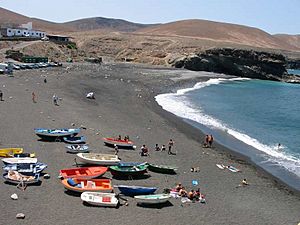
Fuerteventura is known for its beautiful beaches. It was even chosen as one of Europe's most attractive tourist spots for its culture, environment, and sustainability. Some of the best beaches are Playa de Cofete, Playas de Jandia, Playas de Corralejo, Playa de Ajuy, and Playas de El Cotillo.
Wildlife of Fuerteventura

Fuerteventura is home to a rare type of Canarian Egyptian vulture. You can also find many wild dogs and cats. On the rocky land, there are Barbary ground squirrels and geckos. Many birds also visit or nest on the island, like collared doves, swifts, and different kinds of finches.
Even though it's a dry island, Fuerteventura has many insects. Butterflies like the clouded yellow and the bath white are common. You might also see monarch butterflies. Near holiday resorts, where there's more water, you can find dragonflies like the blue emperor. The island's sand dunes are home to bees and wasps, including the blue banded bee.
Hawkmoths also live on the island. One interesting type is Hyles tithymali, which eats local plants.
Natural Symbols
The official natural symbols of Fuerteventura are the Chlamydotis undulata fuertaventurae (a type of bird called a houbara) and the Euphorbia handiensis (a plant known as Cardón de Jandía).
People and Education
Island Population
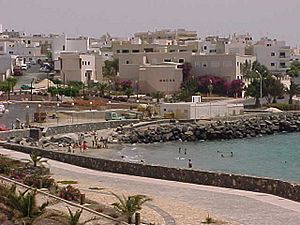
At the start of 2023, Fuerteventura had 124,152 people. For a long time, the island's population went down because of the dry climate and lack of jobs. But since the 1980s, tourism has grown a lot, and the population has doubled in less than ten years!
In 2005, out of 86,642 people, about 30,364 were born on the island. Many people have moved to Fuerteventura from other countries, which has helped the population grow a lot recently.
Schools and Learning
Fuerteventura has 116 schools with 14,337 students. This includes primary schools, secondary schools, and vocational colleges.
The island also has a center connected to the National University of Distance Education. This means students can take many courses, like economics, law, history, and tourism, from a distance.
How the Island is Run
Government of Spain on the Island
Fuerteventura has a special office that represents the Government of Spain. This office manages public services that are not controlled by the Canary Islands' own government. These services include:
- Island Security Forces (National Police and Guardia Civil)
- Ports and the airport
- Tax and customs
- Driving licenses and roads
- Immigration and social security
Island Council of Fuerteventura
The Island Council (Cabildo) is like the local government for Fuerteventura. It was created in 1912. It provides services for the island and acts as the main local authority. The president of the Island Council is elected by the people.
Towns and Villages
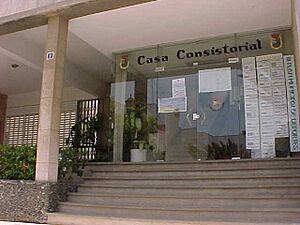
Fuerteventura is divided into six main areas called municipalities. Here's a quick look at them:
| Name | Area (km2) |
Census Population | Estimated Population (2023) |
||
|---|---|---|---|---|---|
| 2001 | 2011 | 2021 | |||
| Antigua | 250.56 | 5,519 | 10,391 | 12,782 | 13,513 |
| Betancuria | 103.64 | 685 | 770 | 755 | 811 |
| La Oliva | 356.13 | 10,548 | 22,827 | 27,503 | 29,174 |
| Pájara | 383.52 | 12,382 | 19,773 | 20,892 | 21,130 |
| Puerto del Rosario | 289.95 | 21,296 | 35,878 | 41,852 | 43,493 |
| Tuineje | 275.94 | 9,843 | 13,302 | 15,494 | 16,031 |
| Totals | 1,659.74 | 60,273 | 102,941 | 119,278 | 124,152 |
These municipalities work together in groups. The largest towns that are not capitals of their municipalities include Corralejo, Morro Jable, Gran Tarajal, and Costa Calma. A small island nearby, Islote de Lobos, is part of the municipality of La Oliva.
Island Economy
Long ago, Fuerteventura was a main exporter of wheat and cereals to other Canary Islands. However, this didn't help the local people much, and many moved to other islands to find a better life.
Today, Fuerteventura's economy mostly relies on tourism. Popular tourist areas are Corralejo in the north, Morro Jable in the south, and Caleta de Fuste near Puerto del Rosario. Other important industries are fishing and farming. The famous Majorero cheese is made here from the milk of local goats.
Tourism and Activities
The first tourist hotel was built in 1965, and the Fuerteventura Airport opened. This started a new era for the island, making it a popular European holiday spot with over 3,000 hours of sunshine a year.
Fuerteventura has great tourist facilities but hasn't been overdeveloped like some other islands. It's a favorite place for European tourists.
The island is a paradise for surfers all year round because of the summer Trade Winds and winter waves from the Atlantic. Areas like Corralejo and El Cotillo are popular for surfing. Windsurfing is also big, especially in Corralejo and Playas de Sotavento. Sailors, scuba divers, and fishermen love the clear blue waters, where you can see whales, dolphins, and turtles. Hikers also enjoy the island's hills and volcanic landscapes.
Many sandy beaches are found across the island. Western beaches, like those near El Cotillo, can have strong waves. The large sand dunes east of Corralejo have popular beaches. The long, protected sandy shores of Playa de Sotavento de Jandia are also a favorite.
Much of the island's interior, with its plains and volcanic mountains, is protected. You can still take organized tours and drive through these areas.
Arts and Culture
Traditional Celebrations
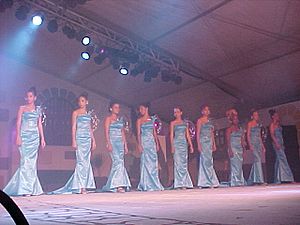
Like the rest of the Canary Islands, Carnival is a huge festival celebrated on Fuerteventura. It happens in February and March in different towns, with parades and galas to choose a carnival king or queen.
Music and Festivals

Many concerts and festivals take place in auditoriums and smaller venues across the island. These include the Festival of Canarian Music and performances by famous bands.
- Lebrancho Rock: Started in 2004, this festival helps local bands perform.
- Fuertemusica: Also started in 2004, this festival in El Cotillo features well-known music groups.
- Virgen de la Peña: Every year in September, people celebrate the Virgen de la Peña, the patron saint of Fuerteventura, with a pilgrimage in the village of Vega de Rio Palmas.
The International Kite Festival is held every November on the Corralejo Beaches. It attracts kite flyers from all over Europe because of the warm, steady winds.
Auditoriums

Fuerteventura has three main auditoriums for performances, conferences, and other events:
- The Isle of Fuerteventura Auditorium
- Gran Tarajal Auditorium
- Corralejo Auditorium
Central Library
The main library for the island is in Antigua's city center. It offers traditional library services, a large multipurpose room, Wi-Fi, and a multimedia room for various events.
Museums and Art
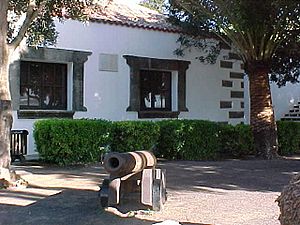
The island has several museums and exhibition spaces, including:
- The Antigua Windmill Craft Centre
- The Salt Museum
- The Atalayita Archeological Interpretation Centre
Sculpture Park
In Puerto del Rosario, there's an open-air sculpture park with about 100 sculptures. These sculptures are created by artists from around the world during the annual International Symposium of Sculpture.
Main Sights to See
In the north, you can find Corralejo and El Jable, which are famous for their fine sand dunes. The south has long beaches and quiet bays. The constant winds make it a perfect spot for windsurfing. Surfing is popular on the west and north coasts where the waves are big. El Cotillo is a small fishing village in the northwest, known for its long beach and calm northern beaches, which locals call "lakes." These calm areas are great for snorkeling.

On the western side of Jandía, in Cofete, there's a remote and impressive house called Villa Winter. It's said to have been built on land given by Francisco Franco.
For a while, the beaches had a famous shipwreck. On January 18, 1994, the ocean liner SS American Star (formerly America) ran aground during a storm at Playa de Garcey. Over time, the ship broke apart and slowly sank, with most of its remains disappearing below the surface by 2012.
Delicious Food
Fuerteventura's food is simple, like that of other Canary Islands, and uses a lot of fish. Locals also use what they can grow in the dry land. A popular dish is papas arrugadas, which are wrinkled potatoes served with mojo, a spicy sauce, or with puchero canario, a meat stew.
Seafood is prepared in many ways, like pejines (salted fish) or sancocho (a fish stew). People also enjoy mussels and limpets collected from the island's coasts.
While beef and pork are eaten, the main meat is goat, either roasted or stewed. Goats are also important for their milk, which is used to make Majorero cheese. This cheese has won many awards and is mostly made from goat's milk, sometimes with a little sheep's milk. It's one of only two Canary Island cheeses with a special protected origin status.
Getting Around Fuerteventura
Airports
The Fuerteventura Airport is the main way to get to the island. It's located near Puerto del Rosario. The airport has flights to over 80 places around the world and handled over 5.6 million passengers in 2016. A new terminal was built in 1994, and new arrivals facilities opened in 2009, allowing up to 4,000 passengers per hour.
Binter Canarias is a regional airline that connects Fuerteventura with other Canary Islands.
Ports
You can also travel to and from Fuerteventura by ferry from four ports: Puerto del Rosario, Corralejo, Gran Tarajal, and Morro Jable. The main port in Puerto del Rosario handles cargo and cruise ships. Passenger ferries mainly use Corralejo (connecting to Lanzarote), Gran Tarajal (connecting to Gran Canaria), and Morro Jable (connecting to Gran Canaria and Tenerife).
Roads
Fuerteventura has two main highways: FV-1 and FV-2. The FV-1 goes from Corralejo in the north to Puerto del Rosario. Part of it is a dual carriageway. A new bypass was opened in 2017 to direct traffic away from the Corralejo Dune Nature Reserve.
The FV-2 connects Morro Jable and Puerto del Rosario. Between La Lajita and Morro Jable, it's a dual carriageway. Many car rental companies have offices at the airport, making it easy to explore the island.
Sports and Fun
Fuerteventura is a great place for many sports, both outdoors and in sports centers.
Local Sports
Canarian Wrestling
This wrestling takes place in a sand ring called a terrero. Two wrestlers try to knock each other over. Fuerteventura has 14 terreros across its towns. The island also has a school wrestling league to encourage young people to play.
Juego del Palo
Juego del Palo is a Canary Islands martial art where two players use sticks to try and "defeat" each other without making physical contact. Its origins come from the combat methods of the island's ancient people.
Canarian Boules
This game is similar to French Pétanque. Players score points by throwing a ball as close as possible to a small object called a mingue. It's played on a rectangular sand or earth court.
Water Sports
The sea and climate conditions make Fuerteventura perfect for many water sports.
Surfing, Windsurfing, and Kitesurfing
Many types of surfing are popular, including traditional surfing, windsurfing (using a sail), and kitesurfing (using a kite). There are many schools on the island to teach these sports.
Fuerteventura is famous internationally for windsurfing and kitesurfing. The International Windsurfing and Kiteboarding Championship has been held here since 1985. Many world champions compete in this event.
Diving
Diving schools are common along Fuerteventura's coast. The island has a wide underwater shelf, making it a great place for diving. Popular diving spots are off Playa del Matorral in the south and between Lobos Island and Corralejo in the north. Corralejo also hosts an International Sea and Submarine Photography Festival.
Swimming
While there are many swimming pools, swimming in the open sea is very popular. An annual swim from Lobos Island to Fuerteventura has been held since 1999. It attracts swimmers from all over Spain, including famous athletes.
Sailing
The island hosts sailing competitions for different types of boats. An interesting event is the Tour of Fuerteventura by Kayak, which is a non-competitive way to explore the island by sea.
Fishing
The most notable fishing competition is the Gran Tarajal Fishing Open.
Other Sports
Since 2004, cycling events like the Marcha Ciclotourista and Criterium Ciclista have been held in La Oliva and Corralejo. These events have helped grow local interest in cycling.
There are also motocross circuits on the island, hosting regular races. Gravel rally races are held throughout the year, with some being part of the Canarian Dirt Rally Championship.
The island's main football clubs are CD Union Puerto and CD Cotillo.
The Playitas resort on the south coast has a 50-meter swimming pool and is a popular training spot for triathletes. An annual triathlon race, Challenge Fuerteventura, is held there.
Famous People from Fuerteventura
- Manuel Velázquez Cabrera: Born in Tiscamanita in 1863, he was a politician and lawyer who helped create the island's council.
- Juan Ismael: A painter, cartoonist, and poet born in La Oliva in 1907. He is known as one of the great Canarian surrealist artists.
- Eustaquio Gopar: Born in Tuineje in 1866. He was a Spanish soldier involved in the Siege of Baler and later became mayor of his hometown.
Images for kids
-
Parish of Santa María de Betancuria, in Betancuria.
See also
 In Spanish: Fuerteventura para niños
In Spanish: Fuerteventura para niños
- Geology of the Canary Islands
- List of volcanoes in Spain


